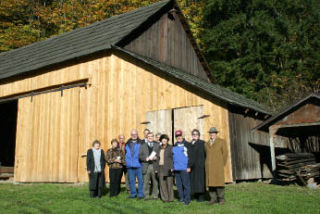Before Alfred and Anna Olson sold the 5-acre triangular strip of land on the north end of their Green River Road farm to King County decades ago, it had been their major field, as the piles of drying hay captured in aerial photographs dating to the 1930s clearly attest.
Now that same strip of land is destined to be a vital part of the restored Mary Olson Farm, providing a place for features the brother and sister could never have imagined there — public restrooms, a parking lot and a path leading from the parking lot to the barn at the heart of the restoration project. Part of it will be returned to an agricultural function like grazing animals or growing hay.
King County Council members approved the transfer of this portion of the North Green River Park to the City of Auburn Monday, Oct. 13.
“Ownership of North Green River Park creates a natural opportunity for the City of Auburn to develop the area into future expansion of Mary Olson Farm,” said King County Councilmember Pete von Reichbauer, whose District 7 includes North Green River Park.
The city owns the farm and leases it to the White River Valley Museum for stewardship and restoration. The museum is raising funds to restore the farmstead’s buildings and landscape, develop visitor amenities, and interpret the farm’s rich heritage. Interpretation will center on family farm economics, stories of immigration, environmental history, and the native landscape.
White River Valley Museum Director Patricia Cosgrove hopes to open the restored farm to the public by the late summer of 2009.
For visitors, the adventure will begin in the parking lot, leading from there along a compacted gravel pathway to the base of an old wagon road then east and up and over the hill.
“Visitors will park and walk over the hill, and while it’s a little grade change it’s pretty gentle,” said Cosgrove. “It’s an old wagon road up and over and down, either to the back of the barn or to the front entry gate, depending on what the event is. If you are not able to make that kind of a walk, we will have a pull-out where you can be dropped off at the front gate. We are designing the parking right now.”
When the farm is not open, the restrooms will be locked and no one will be able to park there.
“We know that the Green River Road is pretty distant from security, and there are a lot of car break-ins and problems along there, so we plan to put cameras and lights at our parking,” Cosgrove said.
Project enhanced
Acquiring the property has answered has answered several long-standing needs.
For one thing, the museum is trying to recreate a historically accurate picture of the farm circa 1902, and that former hayfield, which fed the few livestock the Olsons had, was vital to a farm that otherwise consisted of forested hillside, the Olson canyon and the south pasture. For another, the museum didn’t want to jar visitors to this idyllic farm with images of bathrooms and parking.
“While making people walk over a little hill to get to the site from the lot may not suit everybody, it does leave the farm intact while offering amenities needed for a public park,” Cosgrove said.
The design also calls for in-and-out driveways coming off Green River Road with parking for about 30 cars and two buses. There will be overflow parking in the rest of the field.
“Some of it will be fenced so it can be grazed or cut for hay,” Cosgrove said. “We have worked with architects and engineers to figure out a way to create a parking lot that will not look like a parking lot, but a little more farmlike, meet codes and be very gentle to the environment since we are so close to a river there. We don’t want just to blacktop over it.”
The driveway between the parking stalls and the entry will be some type of permeable concrete that resembles gravel. Cosgrove said the parking stalls will be Grasscrete, which is more like open brick work that has soil and grass growing through and can be mowed.
“It will look like you are driving on a farm road with some mowed parking zones off to the side,” Cosgrove said. “Interestingly, it will probably meet ADA accessibility standards until you get to parts of the wagon road which would be much too steep for that. Where we can throughout the farm, we are making it wheelchair accessible. All the walkways throughout the farm will be a compacted gravel that meets ADA standards. We have gone to a lot of trouble to make the weaving house, the farm house and the barn wheelchair accessible, or accessible for those that don’t want to do steps.”
The most intact 1880s family farm in King County, the Mary Olson Farm is on the National Register of Historic Places. It is comprised of an 1897 hay barn, a 1902 farm house, and several outbuildings dating to the late 19th and early 20th centuries, including a weaving house, smokehouse, garage-ice house, and chicken coop. A year-round stream separates the farmstead buildings from a pasture to the south. To the north, the early wagon road winds around a century-old orchard and climbs over a low rise to another pasture. To the east is a steep wooded hillside, and the Green River flows on the west, lending the farmstead a sense of timelessness and isolation.


